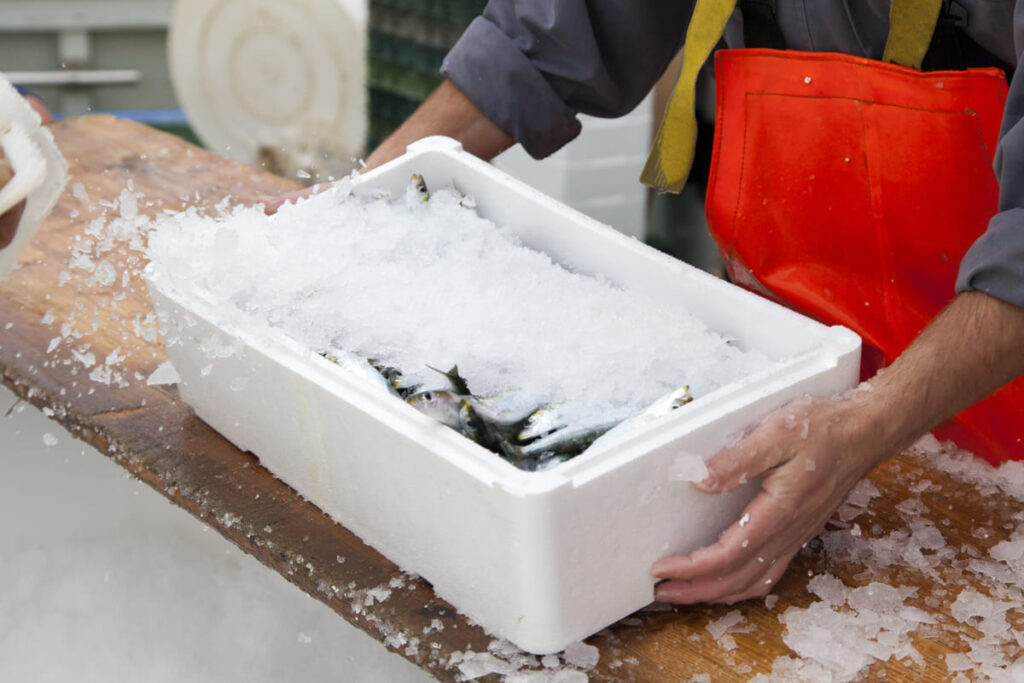When it comes to maintaining the optimal temperature of the cold chain, understanding the various factors and best practices is essential for businesses involved in supply chain logistics. To ensure successful cold chain operations, this blog post will provide insight into packaging solutions and pre-cooling techniques that can help maintain optimal temperature levels.
We will discuss packaging solutions tailored for cold chain logistics, including insulated containers and selecting appropriate materials. Additionally, we’ll delve into pre-cooling techniques and their importance in preserving product quality during transportation.

Furthermore, advanced monitoring systems such as GPS tracking devices and Bluetooth-enabled sensors play a crucial role in maintaining optimal temperatures. We will also examine transportation mode selection decisions based on airfreight vs ground-based options while considering influencing factors.
Last but not least, staff training programs focusing on regulatory compliance are integral to ensuring the proper handling of temperature-sensitive products. Finally, contingency planning strategies and adherence to industry guidelines like IATA standards will be explored as key components for the successful implementation of best practices across all stages of cold chain logistics management.
Importance of Cold Chain Temperature Management
Maintaining optimal temperatures throughout the cold chain process is crucial for industries such as fisheries, seafood distributors, chilled and frozen meat importers/exporters, and food processing plants. Ensuring temperature-sensitive products are transported under ideal conditions minimizes potential risks or disruptions along the way while preserving product quality and safety.
Key Industries Relying on Cold Chain Management
- Fish products necessitate proper temperature control during transit to make sure they get there in perfect condition.
- Seafood Distributors: Seafood products need proper temperature control during transportation to ensure they reach their destination in peak condition.
- Chilled & Frozen Meat Importers/Exporters: Maintaining appropriate temperatures helps preserve the integrity of meat products during transit across international borders.
- Food Processing Plants: Processed foods often require specific temperature ranges to guarantee quality and extend shelf life.
Challenges Faced in Maintaining Optimal Temperatures
The supply chain can pose various challenges when it comes to maintaining optimal temperatures for perishable goods. Some common obstacles include:
- Inadequate insulation or packaging materials that fail to provide sufficient thermal protection during transport.
- Varying environmental conditions encountered en route (e.g., extreme heat/cold) may compromise a shipment’s internal temperature.
- Lack of real-time monitoring capabilities, which makes it difficult for companies to identify issues promptly before they escalate into more significant problems.
By addressing these challenges and investing in advanced technology solutions, companies can ensure the optimal temperature of their cold chain is maintained throughout transportation. This not only preserves product quality but also helps maintain compliance with industry regulations.
Advanced Technology Solutions for Cold Chains
Maintaining the right temperature in cold chains is a challenging task, but with modern technology solutions, it’s more achievable than ever before. Companies can now invest in advanced devices like GPS tracking devices and Bluetooth-enabled temperature sensors to keep a close eye on their shipments throughout the entire supply chain process.
GPS Tracking Devices for Shipment Monitoring
The days of crossing your fingers and hoping your shipment arrives safely are long gone. With GPS tracking devices, companies can monitor their shipments’ locations in real-time. For example, if a truck carrying perishable goods breaks down or gets stuck in traffic, immediate action can be taken to mitigate any negative impacts on product quality.
Bluetooth-Enabled Temperature Sensors
- Data at Your Fingertips: These nifty little gadgets provide real-time temperature data directly to your smartphone or another compatible device via Bluetooth connectivity. No more guessing games when it comes to maintaining optimal conditions.
- Precision Matters: Bluetooth-enabled temperature sensors offer highly accurate readings with minimal room for error – essential when dealing with sensitive products that require strict adherence to specific temperature ranges.
- A Proactive Approach: By continuously monitoring temperatures during transportation, these sensors enable companies to take corrective action immediately if needed – such as adjusting cooling systems or rerouting shipments – ensuring the integrity of the cold chain remains intact.
Investing in advanced technology solutions like GPS tracking devices and Bluetooth-enabled temperature sensors is a game-changer for industries relying on cold chain management. These tools not only help maintain optimal temperatures throughout the supply chain process but also provide valuable insights to make informed decisions, ultimately preserving product quality and safety.
Cutting-edge technology solutions like GPS tracking devices and Bluetooth-enabled temperature sensors are helping companies maintain optimal temperatures in the cold chain. These tools provide real-time monitoring of shipments, allowing businesses to take proactive measures to ensure product quality and safety while preserving the integrity of the cold chain.
IATA Guidelines for Shipping Sensitive Products
When it comes to shipping temperature-sensitive products, the International Air Transport Organization (IATA) has got your back. They have issued guidelines that outline best practices for packaging materials and standard operating procedures during transit.
Following these recommendations ensures strict adherence to specific temperature ranges required by perishable foods or medical supplies, making sure they arrive at their destination in tip-top shape.
Packaging Material Best Practices
- Durable insulation: Choose high-quality insulated packaging material designed specifically for cold chain shipments. This helps maintain optimal temperatures throughout the journey.
- Adequate coolant: Use sufficient amounts of refrigerants like gel packs or dry ice based on shipment size and duration. Remember to follow IATA regulations when using dry ice.
- Tight seals: Ensure all seams are properly sealed with pressure-sensitive adhesive tape, preventing any air leaks that could compromise product quality.
Standard Operating Procedures
- Loading & Unloading: Carefully load and unload cargo while minimizing exposure to ambient temperatures. Keep doors closed as much as possible during this process.
- Maintaining Temperature Control Equipment: Routinely check equipment such as refrigeration units and sensors to ensure proper functioning throughout transportation.
Factors Affecting Optimal Temperatures in Cold Chains
Maintaining optimal temperatures throughout a cold chain shipment journey is no small feat. It requires careful consideration of several key factors to ensure your temperature-sensitive products arrive at their destination in tip-top shape. Let’s dive into these crucial elements that can make or break the success of your cold chain logistics.
Appropriate Packaging Materials Selection
The first step towards maintaining ideal temperatures is selecting the right packaging materials for your products. Hiceay.com offers different kinds of ice machines, such as flake ice machines, and tube ice machines.
The machines are designed to make ice that keeps perishable goods cool and fresh during transit, making them an excellent choice for industries like fisheries and food processing plants.
Pre-cooling Requirements Before Loading
Before loading items onto vehicles or aircraft, it’s essential to pre-cool them according to industry standards. This process helps maintain consistent temperatures throughout transportation by minimizing fluctuations caused by external conditions.
Monitoring Equipment Usage
- GPS tracking devices: These handy gadgets provide real-time location data, allowing you to monitor shipments closely and take immediate action if necessary.
- Bluetooth-enabled temperature sensors: These high-tech tools offer continuous temperature measurements during transit, ensuring that any deviations from optimal conditions are quickly detected and addressed.
Transportation Mode Selection
Your choice of transportation mode plays a significant role in maintaining proper temperatures within the supply chain. Factors such as distance traveled between origin and destination points should be considered when deciding whether air freight or ground transport would best suit your needs.
In short, keeping tabs on these critical factors will help you maintain optimal temperatures throughout your cold chain shipment journey, ensuring that your products arrive at their destination in the best possible condition.
Remember, a well-managed cold chain is essential for preserving product quality and safety while minimizing potential risks or disruptions along the way.
To maintain optimal temperatures in a cold chain, appropriate packaging materials selection, pre-cooling requirements before loading, monitoring equipment usages such as GPS tracking devices and Bluetooth-enabled temperature sensors, and transportation mode selection are crucial factors. A well-managed cold chain is essential for preserving product quality and safety while minimizing potential risks or disruptions along the way.
Staff Training & Contingency Planning in Cold Chain Management
Maintaining the integrity of the cold chain process requires a well-trained staff who can handle temperature-sensitive products with care. Proper training ensures that a person understands how to use monitoring equipment effectively and recognizes when corrective action is necessary based on real-time data analysis.
Let’s dive into why staff training is essential and explore contingency planning for unforeseen circumstances.
Importance of Staff Training
- Knowledge: Employees should be familiar with industry-specific guidelines, such as those from the International Air Transport Organization (IATA), which outline best practices for handling temperature-sensitive cargo during transit.
- Skill development: Properly trained employees are better equipped to manage advanced technology solutions like GPS tracking devices and Bluetooth-enabled temperature sensors, ensuring optimal temperatures throughout transportation.
- Error reduction: Well-informed staff members are less likely to make mistakes that could compromise product quality or safety along the supply chain journey.
Contingency Planning for Unforeseen Circumstances
In addition to investing in employee education, companies must also develop comprehensive contingency plans to minimize disruptions caused by unexpected events during transportation. These plans may include:
- Diversifying suppliers: Having multiple sources for key components or ingredients reduces dependency on any single provider, thereby minimizing potential risks associated with supplier issues.
- Selecting alternative routes: Identifying alternate shipping routes ahead of time helps ensure timely delivery even if primary routes become unavailable due to unforeseen circumstances.
- Establishing backup transportation options: Having access to alternative modes of transport, such as air or rail freight, can help maintain optimal temperatures and ensure timely delivery when road conditions are compromised.
By investing in staff training and developing robust contingency plans, companies involved in the cold chain process can better manage potential disruptions while maintaining product quality and safety throughout their supply chains. The applications include fishery, seafood distributors, chilled and frozen meat importers and exporters, food processing plants, and so on.
Proper staff training is crucial for maintaining the integrity of the cold chain process, ensuring optimal temperatures throughout transportation, and reducing errors. Companies must also develop contingency plans to minimize disruptions caused by unforeseen circumstances such as diversifying suppliers, selecting alternative routes, and establishing backup transportation options.
Regulatory Compliance & Cold Chain Logistics
Non-adherence to the regulations can cause hindrances, fines, or even harm one’s business image.
Local Regulations Affecting Cold Chains
Different countries have varying rules and guidelines governing the transport of perishable goods.
In the United States, the Food Safety Modernization Act (FSMA) sets specific requirements for food transportation to ensure safety and compliance. Similarly, European Union member states follow strict standards outlined by the European Commission on Food Hygiene.
It is crucial that companies involved in cold chain logistics familiarize themselves with all relevant local regulations and ensure their supply chains are compliant.
International Regulations Impacting Cold Chain Logistics
In addition to local laws, several international organizations provide guidance on best practices for maintaining temperature-sensitive products during transit. The International Air Transport Association (IATA) offers guidelines specifically designed for air cargo shipments of perishable items like seafood or pharmaceuticals.

Moreover, the World Health Organization (WHO Vaccine Quality Network – VQN) provides recommendations on handling vaccines at various stages of distribution.
- Action Item: Stay informed about the latest local and international regulations affecting your industry. Regularly review guidelines from organizations like IATA, WHO, or other relevant authorities to ensure compliance.
- Action Item: Develop a robust internal audit system to monitor adherence to regulatory requirements within your cold chain logistics operations. This can be used to spot possible areas of improvement and reduce the hazards related to failing to comply.
In conclusion, maintaining optimal temperatures in cold chains is not only crucial for product quality but also for meeting various regulatory standards. By staying informed about the latest rules and guidelines, investing in staff training, and implementing effective monitoring systems, companies can successfully navigate the complex world of cold chain logistics while ensuring their products reach consumers safely.
Maintaining optimal temperatures in cold chain logistics is crucial for product quality and regulatory compliance. Companies must stay informed about local and international regulations, develop internal audit systems, and invest in staff training to ensure their products reach consumers safely.
FAQs in Relation to How to Maintain the Optimal Temperature of the Cold Chain
How to Maintain the Optimal Temperature of the Cold Chain
To maintain a cold chain system, it is important to use advanced technology solutions like GPS tracking devices and Bluetooth-enabled temperature sensors. Proper packaging material selection, pre-cooling requirements before loading, monitoring equipment usage, and transportation mode selection are also crucial.
Additionally, staff training and contingency planning are necessary for effective cold chain management.
Best Practices for Managing Cold Chain Distribution
The best way to manage cold chain distribution is by implementing standard operating procedures that include appropriate packaging material selection, consistent temperature monitoring throughout transit using advanced technologies such as IoT devices or RFID tags, adherence to IATA guidelines for shipping sensitive products, and regulatory compliance at local and international levels.
Why is it Important to Maintain the Cold Food Chain?
It is essential to maintain optimal temperatures throughout the entire food supply process to preserve product quality and safety while minimizing spoilage risks. This ensures the extended shelf life of perishable goods by preventing bacterial growth or other harmful reactions caused by improper storage conditions.
The Importance of Maintaining the Cold Chain as Required
Maintaining an efficient cold chain reduces wastage due to spoilage, which helps conserve resources and save costs. It also ensures consumer safety by reducing the risk of contamination from pathogens and preserving the nutritional value of perishable items.
Ultimately, this contributes towards improved public health outcomes and meeting global sustainability goals set forth in the UN Sustainable Development Goals.
Conclusion
Effective cold chain management is crucial for businesses dealing with perishable goods. From selecting the right packaging and transportation modes to implementing advanced monitoring systems, there are several factors that can impact the optimal temperature of the cold chain.
Pre-cooling techniques, staff training, contingency planning, and regulatory compliance also play a vital role in maintaining temperature stability throughout the supply chain.
By following the guidelines outlined above on how to maintain the optimal temperature of the cold chain, businesses can ensure their products remain fresh and safe for consumption while reducing waste and costs associated with spoilage.
At Project Hiceay, we offer state-of-the-art ice-cooling technology solutions to help you optimize your cold chain logistics. Contact us today to learn more!


